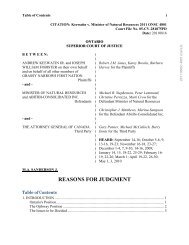Litigation and Dispute Resolution Guide
Litigation and Dispute Resolution Guide
Litigation and Dispute Resolution Guide
Create successful ePaper yourself
Turn your PDF publications into a flip-book with our unique Google optimized e-Paper software.
III. LITIGATING IN COURT1. General Court ProceduresHow is a civil claim (that is, a non-criminal proceeding) dealt with in Canada's courts? Thissection summarizes the stages from the commencement of the lawsuit through to its ultimateresolution. The procedures in Quebec are summarized separately in Section VIII of this <strong>Guide</strong>.This section also outlines the growing use of class actions in Canada. Virtually all Canadianprovinces now have rules permitting representative actions.1.1 Time for Commencing ProceedingsThe time deadlines <strong>and</strong> limitation periods for commencing lawsuits <strong>and</strong> actions are the subject ofprovincial law (with limited exceptions for matters within federal jurisdiction). If a party does notcommence legal proceedings within the applicable limitation period, that party may beprohibited from making the claim thereafter.Limitation periods vary from province to province, <strong>and</strong> often vary within a particular provincedepending on the type of case. Alberta <strong>and</strong> Ontario both have a general two-year limitationperiod for most civil cases, such as breach of contract <strong>and</strong> negligence, but in certain limitedcircumstances, the limitation periods can be much shorter. For example, in British Columbia, thelimitation period to give notice of a claim to a municipal body is only 60 days.In addition to the limitation periods set out in the statutes of the various provinces, there arecertain common law doctrines (such as laches <strong>and</strong> acquiescence) which give the courts discretionto dismiss a claim if the plaintiff did not pursue its rights within a reasonable time.It is recommended that persons with potential actions seek legal advice as soon as they becomeaware of the claims.1.2 PleadingsIn civil actions in Canada, the nature <strong>and</strong> scope of the dispute to be resolved by the court isdefined by the pleadings filed by the parties to the lawsuit. Pleadings are a concise statement ofthe facts that each party must prove to the court to establish that party’s position. The plaintiff isrequired to state (or plead) all of the facts necessary to establish a valid cause of action againsteach defendant, <strong>and</strong> the defendant is required to plead all of the facts necessary to refute thatcause of action. The pleadings are intended to define what facts <strong>and</strong> issues will be relevant attrial.1.2.1 Commencing ProceedingsCommencing a civil action requires an originating document filed with the court <strong>and</strong> served onthe opposing party/parties stating the nature of the claim <strong>and</strong> the relief sought. The Rules of Courtin each province stipulate the specific form required. The vast majority of provinces require anBLAKE, CASSELS & GRAYDON LLP Page 15
















